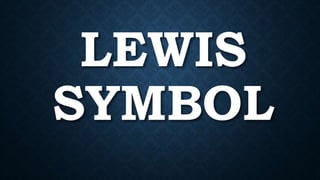
LEWIS SYMBOL.pptx
- 1. LEWIS SYMBOL
- 2. •Gilbert Newton Lewis was an American physical chemist. He was best known for his discovery of the covalent bond and his concept of electron pairs; his Lewis dot structures and other contributions to valence bond theory have shaped modern theories of chemical bonding.
- 3. •A Lewis Symbol is constructed by placing dots representing electrons in the outer energy around the symbol for the element.
- 4. •The Lewis symbol is composed of the symbol of elements and dots that represent the valence electron. Distribute the number of valence electron in the symbol of elements singly first in the four sides of the symbol before pairing.
- 5. •Example: Phosphorous has 5 valence electron P
- 6. •Atoms always strive to attain stable arrangement of electrons. They can only become stable if their valence electrons have the same arrangement as that of the noble gases (have 8 valence electrons except helium).
- 7. •Based on the Octet Rule, elements gain or lose or share electrons to achieve the electronic configuration of the nearest noble gas. Thus, after chemical bonding, elements become isoelectronic (the same electronic configuration) with the nearest noble gas in the periodic
- 9. •Procedure: 1. Some metallic and non-metallic elements are given in Table 1. Write the electronegativity values and ionization energy of the selected elements using Figure 2-3. Subtract the electronegativity value of the metallic element from the non-metallic element. The first metal and non-metal element is given as a sample.
- 10. •Note: A complete transfer of electron is possible if the electronegativity difference is more than 1.9.
- 11. •2. Write the Lewis symbol of metal and non- metal elements in Table 2. With the use of an arrow, show the complete transfer of electrons. Indicate the formation of cation and anion. The first metal and non- metal element is given as a sample.
- 13. •An Ion is an atom or molecule with a net electric charge due to the loss or gain of one or more electrons.
- 14. •Anions are negatively charged ions. They are formed when non-metal gains the electrons. They gain one or more than one electron and do not lose any protons.
- 15. •Cations are positively charged particles that form when an atom or compound loses one or more electrons
- 16. •Not all combinations of metals and Non-metals form ionic bond. Take aluminum and bromine as an example. Aluminum is a metal with 3 valence electron and electronegativity value of 1.6 (EN= 1.6), while bromine is a non- metal with 7valence electron and electronegativity value of 2.8 (EN=2.8).
- 17. •The electronegativity difference is 1.2.These two elements cannot form ionic bond because energy is not enough to facilitate the complete transfer of electron. Instead, another bond is formed called Covalent bond which is the sharing of electrons. Both aluminum and chlorine attain their stability by sharing their valence electrons.
- 18. •An Ionic bond is the bond formed by the complete transfer of valence electron to attain stability
- 19. •A covalent bond is a chemical bond that involves the sharing of electrons to form electron pairs between atoms.
- 20. •Covalent bond has two types: Polar covalent bond and nonpolar covalent bond. If the electronegativity difference is less than 1.9 but more than 0.4, polar covalent bond is formed. Electronegativity difference between 0 - 0.4 results to a non-polar covalent bond
- 21. •Table of electronegativity Difference > 1.9 to 4.0: Ionic Example: NaCl Na EN=0.9 Cl EN= 3.0 •Difference = 2.1 > 0.5 to 1.8: Polar Covalent Example: H2O H EN= 2.1 O2 EN = 3.5 •Difference = 1.4 > 0.0 to 0.4: Non-Polar Covalent Example : Cl2 Cl EN = 3.0 Cl EN= 3.0 Difference= 0